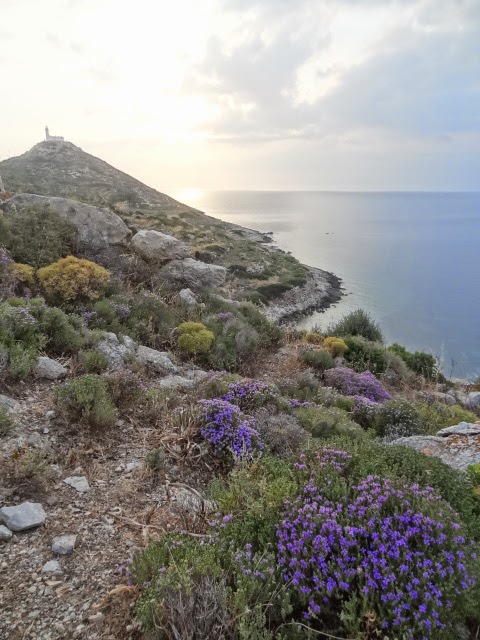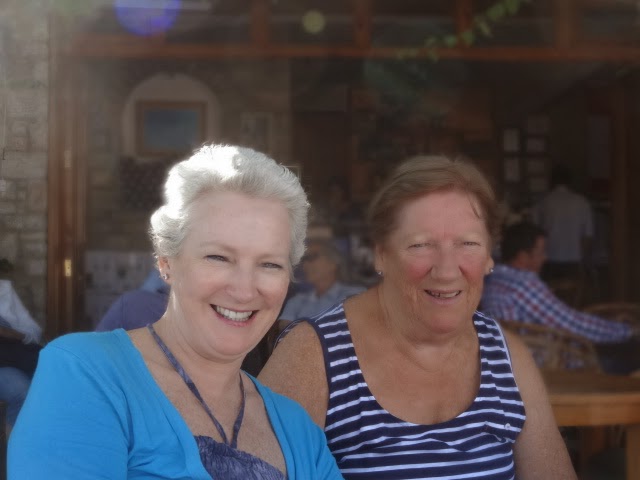Setting off from Sarpdere
Our overnighter from Sarpdere to Eski Foca, our first night
at sea for the season, was quite pleasant. We set off at sunset and had enough
wind to get a couple of extra knots from the sails. It was quite a scenic trip
with the lights glittering from the hills on the Greek island of Khios just a few
miles across the strait. The channel between Greece and Turkey is quite narrow and we had some hairy moments getting squeezed between a 200 metre cruise liner going one way and a 195 metre freighter going the other way with us in the middle. At 2am. Terry said they were lucky they didn't hit us or there would have been hell to pay .

We arrived in the attractive harbour of Eski Foca and scouted around for an anchorage, but once again we were plagued with a failure to dig in. The bottom in most places seemed to be rocky with thick seagrass and we tried both styles of anchor (Manson and Danforth) without success. Finally we headed over to look more closely at the town dock (which appeared to be full) and a couple of blokes guided us into a berth which they said we could sit in until 4pm, when its usual occupant would return from a day sail. We have found the Turkish people to be unfailingly helpful and kind – they love to help you solve a problem! (Problem ? Problem yok!) Well at least we could fill up with water, buy some provisions and have a rest – we were flagging fast and I was just so thankful not to have to drop and pull in that *!# anchor one more time.
Eski (old) Foca (that's 'foe-cha') was the home of the ancient Phocians who
were famous seafarers referred to in Homer’s Iliad. It is a fishing town and a
tourist resort for Turks from the big cities of Ismir and Istanbul – and
everything is much cheaper than the resorts that target foreigners. There are
some interesting ruins here, but unfortunately we were on a limited time
schedule and didn’t have a chance to explore. After a good rest it was off with
the lines and up with the anchor (pausing to disentangle it from someone’s
mooring line) and off to Tatilkoyu a couple of miles to the north. We set
anchor easily in lovely mud and enjoyed the sight of dozens of Hobie Cats,
sailboards and sailing dinghies flitting around the huge bay. A comfortable
night? Not really – the anchor dragged again with a wind change and we had to
do it all again at 2am.
Anchors! They’re giving us hell at the moment, refusing to
set, refusing to hold. We take our time and do it right, but I think the seabed
must be a bit rocky and unfriendly in these parts. Wherever possible I dive in
and check if it’s holding, but you can’t do that in low visibility or bad
conditions. And now, as we tried to set off in the morning, the Danforth came
up with about half an acre of mud, rock and seagrass attached, which no amount
of dunking would dislodge. Bit by bit we cleared it with hands and boathooks.
The wind was strong from the north, so it was a hard but uneventful beat up to
Bademli Limani.
Bademli Limani
This is a very sheltered little harbour, now pretty much
silted up so that only small fishing boats have access. Fishing is its reason
for being – there is not much here apart from working boats and tough old
fishermen mending their nets – but it is a safe anchorage and quite scenic. I swam
over to greet the only other cruisers there, and of course they were Aussies,
David and Jenny from Sydney aboard Windjammer III. Terry and I managed to
locate the only (fish) restaurant where we enjoyed an excellent meal
overlooking the shoals and an abandoned yacht, transformed into a reflection
pool in the moonlight. A wander around the dusty little village next day, then
off early in the morning for the 20 mile hop to Ayvalik.
Passing the island of Alibey, entrance to Ayvalik 'lake'
When you enter the enclosed bay of Ayvalik through a narrow
channel, the vivid blue of the Mediterranean slowly changes to jade green. The
seagrass is lush, fish leap: the water in this bay, known as “the lake”, is
biological, full of life. And then you pass a bubble of bright Med blue against
the green. Then another … and another. Then one the size of a basketball!
Brilliant blue jellyfish surround the boat, their bells hemispherical and
glossy, frilly skirts hiding a spray of short tentacles. These are barrel
jellies, Rhizostoma pulmo. They are
prolific here in the sheltered bay and they really do look like fragments of
Mediterranean blue that have strayed into foreign waters. They can grow to the
size of a dustbin, apparently. Like slow-beating hearts they make their way
purposefully in one direction or another, seeking richer blooms of plankton,
perhaps. They are beautiful, like dancing glass, but we take a break from
swimming of the boat.
Rhizostoma pulmo
We anchored first in the south easternmost bay, accessed through a very narrow channel, and spent two days dug in firmly for a change. We dinghied ashore a couple of times, and even went to the far end of the bay to a wrecked twin engine plane that almost made it to the water to land but came up about 50' short. Of course, there is a Geocache inside it and Terry just had to get it.
Once again, we were alongside Windjammer III with David and Jenny and had a pleasant drinks evening on board their very comfortable Hunter 46.
The next two days forecast strong north-easterlies, the
start of the dreaded Melteme again, so we will head into Ayvalik Setur Marina
for fuel, food, water, waste pump-out, hot showers and a safe haven for a
couple of days. We will use the time to visit the ancient city of Pergamon and also the island of Alibey, which we passed on our way in to Ayvalik.
Marina bar, Ayvalik










































